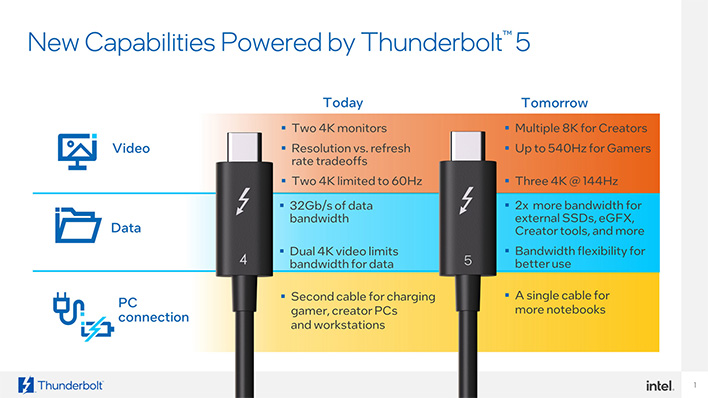Intel Unveils Thunderbolt 5 With A Massive Speed Boost And Gaming At 540Hz

Intel has announced a new version of Thunderbolt connectivity that offers substantially greater performance and capability compared to the previous generation. Known as Thunderbolt 5, the new I/O standard offers transfer rates of up to a whopping 120Gbps of throughput, triple that of previous generation Thunderbolt 4, and support for high resolution 8K displays and refresh rates of up to 540Hz.
Thunderbolt 5’s biggest improvement is the raw bandwidth that it now delivers. Compared to the 40Gbps of bandwidth offered by Thunderbolt 4 and 3, Thunderbolt 5 offers three times more bandwidth (bi-directional) when fully saturated. However, it comes with a little caveat, a third of that speed comes in the form of what Intel calls Bandwidth Boost, that provides the full 120Gbps data rate when utilizing video-intensive devices such as monitors, meaning that most devices will typically only get access to 80Gbps speeds. Still, that is extremely fast and double the data rate of Thunderbolt 4/3.

The higher bandwidth enables Thunderbolt 5 to run significantly more displays in a multi-display setup as well. Intel highlighted the fact that Thunderbolt 5 can run multiple 8K resolution monitors for creators, and up to 540Hz monitors for gamers. For heavy mulit-monitor use, Thunderbolt 5 can even run up to three 4K displays at 144Hz. By comparison, Thunderbolt 4 was limited to just two 4K monitors at up to 60Hz.
Thunderbolt 5 also comes with the latest connectivity standards for hooking up monitors, USB devices and storage solutions, offering USB4 V2 compatibility, DisplayPort 2.1 functionality and PCIe Gen 4 support for high speed M.2 SSDs. Thunderbolt 5 also utilizes a signaling technology known as PAM-3, that delivers substantially greater data rates with current generation circuit boards, connectors and cables with a length of up to 1 meter.
Compared to USB4 V2, Thunderbolt 5 offers very similar capabilities, especially in terms of bandwidth, where both I/O solutions top out at 120Gbps. Where Thunderbolt 5 excels over USB4 V2 is its specification requirements, which enforce 120Gbps support on all Thunderbolt 5 supported devices. This is not the case with USB4 V2, which has a 20Gbps required limit, and three optional data transfer rates that go up to 120Gbps. With Thunderbolt 5, it’ll be very easy to understand what the port is capable of without diving into manuals or spec sheets. The new standard will also be backwards compatible with Thunderbolt 4 and 3.
Intel also shared a demonstration video showing off Thunderbolt 5’s capabilities. The test setup consisted of a prototype Aorus gaming laptop and prototype dock, featuring Thunderbolt 5 support. The dock was hooked up to a 6K and 4K monitor, and connected to two high speed PCie Gen 4 NVMe SSDs that were installed inside the dock itself. The demo showed the monitors and the drives running perfectly with the Thunderbolt 5 notebook, with the drives outputting speeds of up to 6.22GB/s and 5.38GB/s in read and write speeds.
Systems equipped with Thuderbolt 5 are expected to be available starting in 2024, along with a new Intel controller code-named Barlow Ridge that will feature Thunderbolt 5 support for motherboard implementations.


